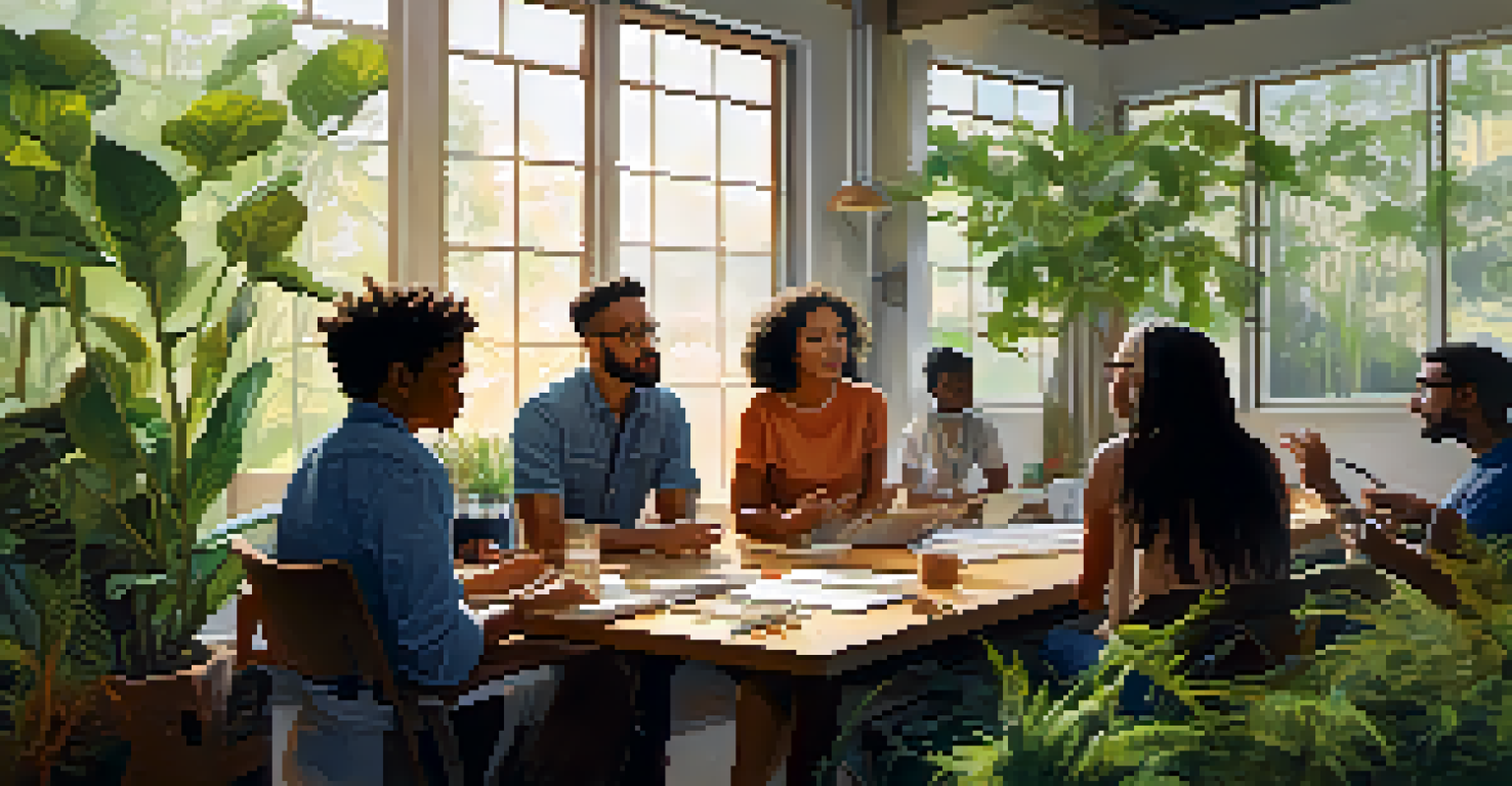The Impact of Entheogens on Cultural Heritage and Identity

Understanding Entheogens and Their Role in Cultures
Entheogens are substances, often derived from plants, that are used in a spiritual or religious context. These compounds have been integral to various cultures, serving as tools for communion with the divine or as facilitators of profound personal insight. For instance, indigenous tribes in the Amazon have long used ayahuasca in rituals to connect with their ancestors and the spirit world, demonstrating the deep-rooted nature of these practices.
The use of entheogens in spiritual practices serves as a bridge between the individual and the collective, reminding us that our personal journeys are intertwined with the stories of our communities.
The significance of entheogens extends beyond mere ritual; they often embody the values and beliefs of the communities that use them. By participating in these experiences, individuals reinforce their identity within the cultural framework, fostering a sense of belonging and continuity. Thus, entheogens can act as cultural anchors, grounding people in their heritage while also allowing for personal exploration.
This connection between entheogens and cultural identity highlights how these substances can shape not only individual experiences but also collective narratives. As societies evolve, the meanings and practices surrounding entheogens can shift, reflecting broader cultural changes while still holding onto their historical roots.
Historical Perspectives on Entheogens in Cultural Practices
Throughout history, various civilizations have utilized entheogens as part of their spiritual practices. The ancient Greeks, for example, celebrated the Eleusinian Mysteries, where participants consumed a sacred drink believed to induce mystical experiences. Such rituals not only provided personal transformation but also reinforced social cohesion among participants, showcasing the dual role of entheogens in shaping both personal and communal identities.

In many indigenous cultures, entheogens have been employed to heal individuals and communities alike. For instance, the use of peyote among Native American tribes is not just about the substance itself but about the collective experience that brings people together. This reinforces cultural values such as respect for nature and the interconnectedness of life, further embedding these substances into the cultural fabric.
Entheogens Connect Culture and Identity
Entheogens serve as cultural anchors, helping individuals reinforce their identity while facilitating personal exploration.
As we examine these historical uses, it's clear that entheogens have played a significant role in the evolution of cultural heritage. Their continued relevance in contemporary practices speaks to their enduring power in helping people navigate the complexities of identity and spirituality.
Modern Reclamation of Entheogenic Practices
In recent years, there has been a resurgence of interest in entheogenic practices, particularly among younger generations seeking deeper meaning in their lives. This modern reclamation often involves exploring ancestral traditions and integrating them into contemporary contexts. Many people are finding value in reconnecting with these practices as a way to address the disconnection often felt in modern society.
As we navigate the complexities of modern life, reconnecting with ancient practices can provide profound insights and a sense of belonging that many seek.
This revival isn't just about the substances themselves; it's about understanding the cultural contexts in which they are used. Workshops and retreats focused on entheogenic experiences often emphasize respect for indigenous traditions and the importance of setting and community. This approach fosters a more responsible and culturally sensitive engagement with these powerful tools.
Moreover, this resurgence is contributing to a broader dialogue about mental health and personal growth. As more individuals share their transformative experiences with entheogens, they're helping to dismantle stigmas while simultaneously celebrating cultural heritage.
The Role of Entheogens in Personal Transformation
Entheogens have a unique capacity to catalyze personal transformation, prompting individuals to confront their inner selves. Many users report profound insights or shifts in perspective following their experiences, which can lead to significant changes in how they view themselves and their place in the world. This transformative potential often plays a crucial role in shaping individual identities.
For instance, a person might engage with an entheogen and emerge with a renewed sense of purpose or direction in life. The insights gained can lead to healthier relationships, enhanced creativity, and a greater appreciation for the interconnectedness of all beings. Thus, the impact of these experiences can ripple outwards, influencing not just the individual but their community as well.
Modern Interest in Ancestral Practices
A resurgence of entheogenic practices among younger generations reflects a desire to reconnect with ancestral traditions and address modern disconnection.
As people integrate these insights into their lives, they may find themselves more aligned with their cultural heritage, reclaiming aspects of their identity that resonate with their experiences. This interplay between personal growth and cultural connection underscores the multifaceted impact of entheogens on identity.
Entheogens and Cultural Heritage Preservation
As societies evolve and encounter globalization, the preservation of cultural heritage becomes increasingly important. Entheogens are often at the heart of these traditions, serving as both spiritual tools and cultural symbols. By recognizing and valuing these substances, communities can actively work to preserve their unique cultural practices for future generations.
Initiatives aimed at protecting indigenous knowledge surrounding entheogens are emerging, emphasizing the importance of respecting traditional practices. This not only contributes to the preservation of cultural heritage but also fosters a sense of pride among community members. When people understand the significance of their practices, it empowers them to continue these traditions in a meaningful way.
Moreover, as awareness of the ecological significance of these plants grows, there’s a push for sustainable practices that honor both the environment and the cultures that depend on them. This holistic approach to preservation highlights the deep connections between entheogens, cultural identity, and environmental stewardship.
Challenges in the Modern Landscape of Entheogens
Despite the growing interest in entheogens, various challenges persist in their modern application. Legal restrictions in many countries inhibit access to these substances, limiting the ability of individuals to explore their potential benefits. This often leads to a disconnect between cultural practices and contemporary needs, as people seek alternative paths for personal and spiritual growth.
Additionally, the commercialization of entheogenic experiences raises ethical concerns. As retreats and workshops become more popular, there is a risk that the cultural significance of these practices may be diluted or exploited. It's essential for participants to approach these experiences with respect and awareness of their origins, ensuring that they honor the traditions from which they stem.
Challenges in Entheogen Utilization
Legal restrictions and commercialization pose significant challenges to the respectful and meaningful use of entheogens in contemporary society.
Navigating these challenges requires a balance between modern exploration and respect for historical practices. By fostering open dialogue about the implications of entheogen use, communities can work towards creating inclusive spaces that honor cultural heritage while promoting personal transformation.
Looking Ahead: The Future of Entheogens in Culture
The future of entheogens in cultural practices is an evolving landscape, shaped by ongoing research, societal shifts, and personal narratives. As more studies highlight the potential therapeutic benefits of these substances, there’s a growing interest in integrating them into broader discussions about mental health and spirituality. This could pave the way for a more nuanced understanding of their role in both individual and cultural identities.
Moreover, the blending of traditional practices with modern science offers exciting possibilities for the future. Collaborations between indigenous knowledge keepers and contemporary researchers could lead to innovative approaches to healing and self-discovery, while also emphasizing the importance of cultural preservation.

Ultimately, the continued exploration of entheogens will likely reflect the evolving nature of culture and identity itself. By embracing the complexities of these substances and their impact, societies can foster deeper connections to their heritage, while also encouraging personal growth and transformation.